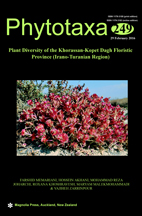Abstract
The Khorassan-Kopet Dagh (KK) floristic province is located in the northeastern parts of Iran and partly in southern Turkmenistan. The area is a transition zone and a corridor connecting different provinces of the Irano-Turanian region and also Hyrcanian montane forests of the Euro-Siberian region. The unique combination of Irano-Turanian species and also presence of a local center of endemism are evidence of a separate biogeographic entity. The complicated topography, high habitat heterogeneity and vegetation history are reasons for the development of diverse vegetation types. In order to achieve up-to-date information on the plant diversity and distribution patterns, a database was prepared using all floristic records from the area defined as KK. A total of 2576 species/infraspecific taxa belonging to 702 genera and 112 families of vascular plants have been reported from the area, 2498 of which occur within Iran. Altogether, 28 different distribution patterns are recognized among five major phytogeographical groups, including widespread, tri-regional, bi-regional, Euro-Siberian and Irano-Turanian patterns. Irano-Turanian elements, which make up the core flora of KK, are subdivided further into 14 distribution patterns. A significant number of species, i.e. 356 species (13.8%), are endemic to the area. The flora of KK is highly influenced by central Irano-Turanian elements. The main vegetation types of the area include Juniperus woodlands, Pistacia vera woodlands, some isolated enclaves of Hyrcanian forests and scrub, cliff vegetation, mountain steppe communities, semi-desert steppes, loess and marl vegetation, halophytic vegetation, aquatic and hygrophilous communities, and ruderal/invasive plant communities. There are several major threats to the ecosystems and biodiversity of the area. The areas presently protected do not cover all of the vegetation types, and therefore many threatened species are not safe.

